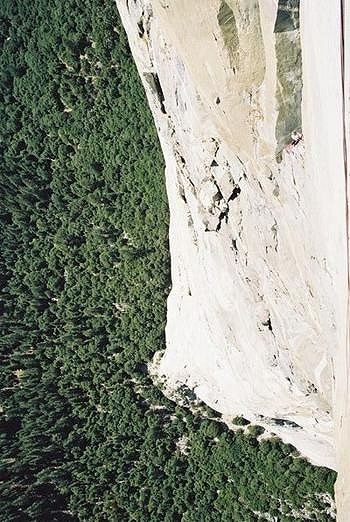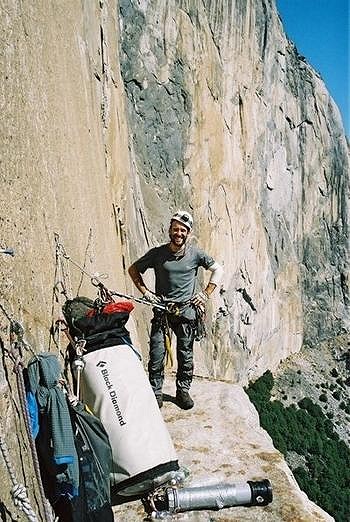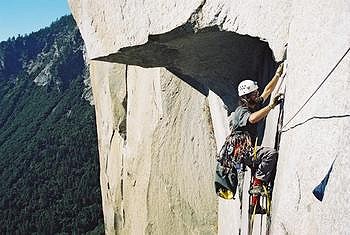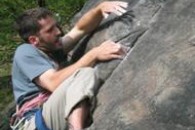The Nose, El Capitan, Yosemite Valley, California (5.8 C2)
The idea
Sometime earlier this year Keith mentioned he was off to New York in the autumn. Did I want to follow him out to Yosemite and climb The Nose on El Capitan? At this point I can't say that I knew about Yosemite. I was aware of the Valley's existence and knew that there was a large vertical granite face called El Capitan. I'd watched "Blood, Sweat and Bagels" but the climbing was just hard trad and I'd never looked past the climbing to see the surroundings. Somewhere I'd read about big walling and had a vague hankering to own a portaledge. As a gear freak it's a must-have after all, imagine pitching up in North Lees or Fontainebleau and rigging your tent to hang above the sodden ground. But actually sleeping on a wall?
For some reason I said yes, and the next weekend stopped in Hathersage to have a look at the guidebooks. The days walking in Cheedale with Mum was spent in delicious anticipation, wishing for a return to the car park when I could read my mornings impromptu purchases. That night in the Vaynol I spent an unsociable night with my nose buried in the pages of Chris McNamara's Supertopo. Everyone contributed to the noise as we tallied a draft gear list: "wadudu spray, (hanging?) stove, finger tape, poop tube" and other exotic items. Back at work I booked holiday and the tickets to San Francisco. I was committed (read gung-ho). After all, how hard can it be?

A lot to learn takes time, so lacking a belay slave I did it solo. From slabs the routes got steeper and then moved to corners and overhangs. Sometimes self-belaying on top-rope, sometimes leading ground-up. C1 seemed easy. Every placement was bomber and felt secure. Top-stepping was fine, until the placements became bodyweight only and then everything got harder and harder. C2 was definitely a different kettle of fish and my limit on the sharp end. By now I'd made contact with my wall doctor in Canada and a flurry of daily emails provided hints, tips and feedback throughout my education.
By now I'm spending almost every spare moment dreaming about the climb. The topo was plastered on my kitchen wall & cubicle at work, the gear lived in the back of my car and colleagues were describing me as obsessed. Google Earth is highly recommended for all valley obsessives - check out the high resolution overlay for El Capitan and fly all around it.
The head game
Leading on aid is a completely different kettle of fish to trad climbing. From a total body awareness, looking for holds and multiple points of contact with the rock, making the moves and finding rest points, planning the gear placements and fall potential. Aid demands total concentration and all that concentration is focused on the last piece of gear. The one that all your weight is hanging from. Every facet of the placement is analysed in great detail and occupies the whole awareness. The tiniest karabiner shift is magnified a thousand-fold and when a piece blows it comes as a complete surprise to find yourself airborne. No gradual slipping from a grit sloper or polished limestone ledge here. Every aid lead is a hard climb.
My departure now looms large and it's time to push my lead grade back up. The first weekend features the polished horrors of Almscliff Low Man and I'm not sure I can do this anymore. The temptation to grab the gear is almost overwhelming but perseverance is the order of the day. Gradually it all comes back and I'm solid on HVS, wanting to push it further but unwilling to risk injury this close to the big adventure. I'm feeling confident about my preparedness (about as well prepared as you can be on single pitch crags) but my stomach is home to plenty of butterflies as I'm thinking about what the valley must be like.
The valley
From Leeds to Oxford to Heathrow to San Francisco. A sweaty evening spent on the Greyhound and a grimy motel in Merced. The bus to Yosemite leaves in the morning and I can hardly sleep with anticipation. The bus driver tolerates me hanging over his shoulder for two hours and laughs at my gasps of delight as I spy the first slabs of granite as we enter the valley. "You haven't seen anything yet" and "That's nothing". He was right. If you take a car, stop at Tunnel View for the classic view of El Capitan. There's no public transport back out to this point so you'll have to walk or hitch out to/from the meadows otherwise. Don't worry, the merest glimpse will leave the image burned on your retina for many weeks to come.
Then you spend some time in the meadows with a pair of binos picking out the route and watching other climbers on El Capitan. It starts to break down into pitches and some of it actually looks do-able. Some of it. Tourists complain that they haven't seen a single climber and you point out the twenty-odd teams on the wall. The look of disbelief in their eyes when you say "That'll be me soon" makes you ponder that confident attitude you exhibited back home. Quite simply it's big. HUGE! F***ING GINORMOUS!!!! How the hell am I going to climb that?
The Yosemite way

Yosemite is granite, perfect granite. So it demands something different in terms of technique. Perfect jamming cracks split an otherwise featureless slab. All four points of contact in a straight line so that slipping out of balance means the first thing to hit the rock is your ear. Flared polished offwidths and chimneys threaten to spit you out at every opportunity. And it's all so big. The average layback pitch is 50m high. What can you do to practise for this sort of climbing in the UK? My hands and nails begin to hurt. My body needs a rest day.
The mock exam
Time to pack the pig and get on a wall. Everything only just fits in. We did South Face on Washington Column in two days then abseiled back to Dinner Ledge after topping out and did a few pitches on Skull Queen for good measure. This was a valuable learning experience as our system got smoother. The column is worth doing for pitch two (P2) and the Kor Roof alone. Get good gear in over the roof. I didn't and stepped up on a Wild Country zero with two and a half cams in. I almost cried for my mummy! Giggling all the way up the bolt ladder on Skull Queen pitch five was a lot more fun. Meeting other parties on the descent we handed our topos to scary Leslie, "the sawn off angles lady" and headed into the Awahnee Hotel for a celebratory beer.
Time for a couple of rest days and one more day of climbing at Five Open Books. I was almost stopped by 5.8 on the third pitch of Surprise. Which came as quite a shock as I'd been cranking it out on 5.10a up to now. Clearly Yosemite granite had held something back in reserve. No more time to practise though, we're flying home in eight days.
The Nose
The last rest day was mostly spent shopping and packing, followed by an appalling night's sleep. I get very nervous before big climbs. Dawn comes cold and way too early. Time to get on it. This is the biggest commitment point. Jugging back up to Sickle on day two is almost as bad with a marathon effort of 160-170m of jugging.
I led all the pitches on the first day for maximum speed with a complete mix of free, french free and aid. It's traditional for me to take a fall on every big route, and The Nose was no exception. Stuck out in middle of P4's tension traverse I barndoored off the twin pinscars and slammed backwards into the corner below. Thank god for helmets. My elbow would stay wrapped in a compression bandage for the rest of the climb, and a fortnight afterwards. A leisurely lunch on Sickle at one o'clock recovered morale followed by a superhuman effort from Keith to haul direct from the ground to Sickle which is highly recommended. The 4th class on pitch zero would be hell to haul. I fixed (roped solo) pitch five whilst he was hauling and we headed home to camp 4. Finishing in the daylight would be something of a novelty for the next four days.
The second day is a ball breaker, the jumar is no fun straight after breakfast. Keith used all the gear that would fit on the first 10m of the Stovelegs and then somehow managed to aid the rest on overcammed and tipped-out friends. I took over and led the last pitch to Dolt Tower in the dark. This is an ideal bivy spot with multiple levels and a complimentary reek of pure ammonia. More effort and speed would have meant getting to El Cap but there's several traverses to follow and unless you've really practised them they will just eat into the climbing day. Plus getting to El Cap Towers on day two means you have the Texas flake for breakfast, not something I wanted to do. We aided something on almost every pitch, some were up to 70% free but they were the minority.

I know that Keith wanted to bail after day two as it was plastered all over his face, but he never vocalised it until we summitted so we'd racked up that morning. The first three pitches had gone like a dream and from this point everything had fallen into place, except for running the last two pitches of the day together, in complete darkness and only reaching a crappy ledge in time to eat and fall asleep after midnight, just below Camp IV.
It was waking up on day four that I knew we would send (I have never slept as well as I did on the wall). By now I was inured to the minor pains and aches (I sat on all my gear for 2 hours without noticing that the belay seat was uncomfortable) and was refusing to put my rock boots on because I could aid faster than I could french frig with my toe torturers. The day got even better with Great Roof, Pancake flake and the start of the corners to the top. Astonishing exposure from the start of the day to the very end.
Tommy Caldwell & Beth Rodden: the third (and first team) free ascent of The Nose caught up with us below the Great Roof and stayed behind the rest of the way. We thought they were working the route still, if I'd have known they were actually on their free ascent I might have paid more attention and taken some photos. One of the wonderful things about aid climbing is that it actually takes you into territory you'd never see close up unless you were on the end of an abseil rope. It's overhanging by five or ten degrees and the crack isn't even deep enough to take an RP, let alone a fingertip. How do people climb this - are they even human?
There was a party on Camp VI so we slept on the ledge below (marked ok bivi for one) which was fine with Keith in the hammock so I got the best bit of the ledge. Again we did the last pitch in the dark. I rigged a series of slings along the ledge to keep me from sliding off which made for a very comfortable night. Not bad considering that I've seen (but not slept on) wider park benches. Visiting Camp VI in the morning it was clear that we'd have needed nose plugs to sleep up there, the approach to every bivi spot is obvious by the urinal scent that announces your approach.
At some point it's easy to finish up than to bail, though I don't recall exactly when that was.
The last day (the fifth) just kept coming, and coming. Keith got his first aid crux on C2 gear (micros) and the endless corners are sapping. The rock's vertical/overhanging for the last day and half and it's a bitch. I'd forgotten my froggie loop so the jugging was a bitch too. By now I was french freeing 5.6 and aiding anything that looked even remotely awkward. Keith topped out on the last pitch just before dusk and was greeted by Jools and Bet who'd come up to meet us. Their squeals of delight drowned out any climbing calls that might have been coming my way. Take time to enjoy the view on the last two belays - it's straight down the whole route. Keith didn't clip the first bolts on the bolt ladder so when I unclipped from the last belay it was a gut wrenching swing out over 3000 foot of clear air all the way down. I wouldn't have chosen any other way to finish the route (though slightly more daylight would have been nice).
We slept on the summit, in one of loads of good bivi sites around the rim - complete with campfires. Our walk off was via the Upper Falls trail in the morning. There's nothing like an eight mile hike with a pig on your back to round off a big wall. Something about careering down the paths with the pig causes ascending tourists to make way. Or maybe it was that thousand-yard-stare. Make sure you keep some water & food in reserve for the descent. We had just about enough but that first beer back in Camp 4 tasted like nectar. Home sweet home.
The aftermath
That afternoon we headed back to meadows to pose in front of El Capitan and revisit the route through binoculars. Pointing out climbers to a family of tourists in the meadow earnt me a smile. Heads shook when they found out I was a climber. Sandwiches and several glasses of wine were pressed upon me when I described topping out twenty hours earlier - my first meal bummed as a big wall rat.
Two weeks later I'm still on a high every time I think of the valley, look at the photos or catch myself trying to pull on gear. It's dirty, crowded and expensive. But I'll be back whenever she'll have me. If I ever forget I'll just have to poke my fingers through the holes I wore in my gloves.
So you want to climb El Capitan
Don't plan for contingencies, or to do this or that when you get back to the valley early. Don't commit anything less than 200% to the climb. Success can be the only thing on your mind. Nothing in these fair isles even comes close to several thousand vertical feet of unblemished rock. Just standing beneath it will remain with me for a long time. I'll never forget topping out. One quote kept coming to mind whilst I was on El Cap - "awash in a sea of granite" - it summed up the surroundings nicely. If you're thinking of El Cap - get out there and get on it.
PS. I never did buy that portaledge.
Recommended Websites
Rockclimbing.com
Search for Dr Piton's old posts, especially for the gear lists and indexes. The forum's kinda quiet but it's a goldmine of information to dig in.
Fish Products
Russ 'the Fish' Walling's treasure trove of big wall advice and gear.
Supertopo
Home of some big wall legends (and Dr Piton), lurking here is a constant pleasure.
These forums will direct you to the hundreds of other sources around the internet, or Google it...
Recommended Books
Yosemite Big Walls - Supertopo
Yosemite Free Climbs - Supertopo
The Road to the Nose - PDF from Supertopo
Big Wall Climbing - Long and Middendorf
Camp 4 - Steve Roper
El Capitan - Daniel Duane
Recommended DVDs & Videos
Climb The Nose Faster by Hans Florine is a packed with useful information on all things the Nose. It is available as a download and as a CD here.
Blood, Sweat and Bagels - Sheffield's finest take on Salathe Wall free
Action Adept Yosemite Valley - lots of hard aid footage
The Centre of the Universe - the Hubers showing off
Cold Haul - captures the physical demands of aid climbing
Return2Sender - parallojams from finger cracks to offwidths
Best Forgotten Art - how to jam in a peak stylie
Steve Mead wishes he'd discovered climbing earlier than the summer of 2002. Since his first touch of real rock (Flying Buttress at Stanage) climbing has been an obsession which took him all over Britain, France, the Alps and Kenya before the trip to California. After moving to Leeds last winter he's living the highlife with sunny gritstone evenings, forays into the Lakes and Scottish winter on the doorstep (compared to London). Two return visits to El Capitan are planned for 2006: Salathe Wall being next on the big wall ticklist.More photos and information on Yosemite climbing can be found on Steve's website.




Comments